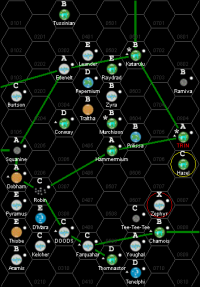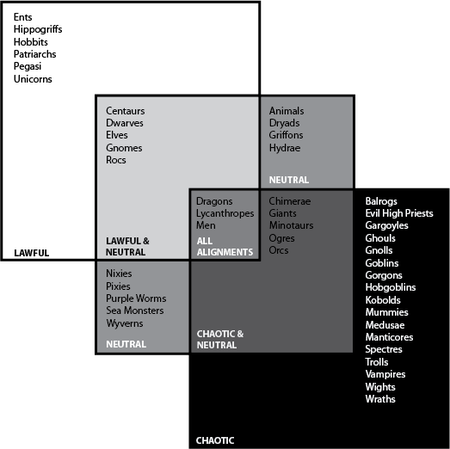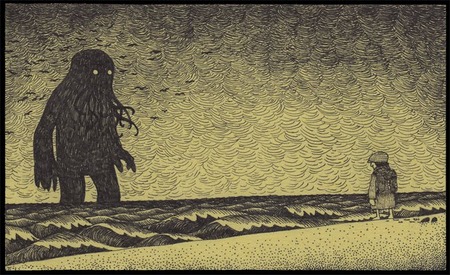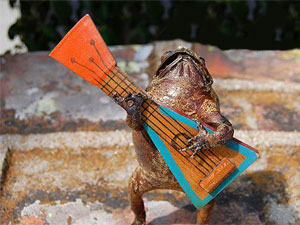 Between 1990 and 1992 I ran a home-brewed RPG generally known as "Jed's Conspiracy" game. Largely inspired by Mark Vest's Twilight 2000 Mercenary game, it emphasized a freewheeling sandbox type game where each week's adventure was devised mostly on the fly.
Between 1990 and 1992 I ran a home-brewed RPG generally known as "Jed's Conspiracy" game. Largely inspired by Mark Vest's Twilight 2000 Mercenary game, it emphasized a freewheeling sandbox type game where each week's adventure was devised mostly on the fly.
The basic structure was inspired by Marks game (have players roll up fairly normal characters in the 'real world', give them access to money and weapons, and then have super powerful organizations be constantly trying to kill them for no clearly defined reason. I was also inspired by Silence of the Lambs, and the idea of an FBI procedural game struck me as a novel approach.
(A year after the game wrapped-up, the X-Files premiered on FOX, and I realized I probably should have thinking more about screenplays then RPGs.)
At that time I was working as a DJ on the student run radio station WRFL, doing the early morning shift on Saturdays. Back then the station had an AP machine (basically a dot-matrix printer hooked up to the AP's news wire network. It was constantly printing out news updates, as they 'came off the wire'...) and so I had lots of time to read random news stories in the early morning while playing records. So I for the game, I would look at the stories with an eye toward secret events happening in the world. (I was deep into Foucault's Pendulum at the time, as well as Holy Blood, Holy Grail, and a host of other Conspiracy books available over in the front room at Sqecial Media on S. Lime.)
Since I had been playing RPGs with some of the players since high-school, and we had shared interested, I was worried that they would figure out the conspiracy pretty quick. So I decided to approach things a little differently- I wrote up 9 different secret organizations that were all (for the most part) un aware of each other's existence. They were varying styles, ranging from a high tech corporation in Boston using computers to predict future history (ala Foundation) to an ancient order of Psychics based out of Europe, to Rasputin who was secretly still up to no good. All of them would do anything to avoid being exposed, and all of them (with one exception) were absolutely convinced that they were heroes out to save the world from a threat only they could see.
Into this I dropped the players, and put them right on the spot when two of the powers would first encounter each other, and naturally each thought the PCs were working for the other guy and tried to kill them. The original players were:
- Chaz Haws as FBI Agent ???
- Trent Reid as FBI Agent Jack Keck
- Chad Martin as Timothy "Hopper" Morgan, typical liberal arts college student at UC Berkley
- Mark Tarter as Insurance Investigator Stone, generally known simply as Insurance man.
The Party's natural talent for mayhem, (particularly Insurance man's) meant that the more the powers tried to kill the party, the more additional powers were alerted to their existence. Also they were labeled in the news outlets of the game world as the 'Reno Renegades' (no relation to the minor league hockey team.)
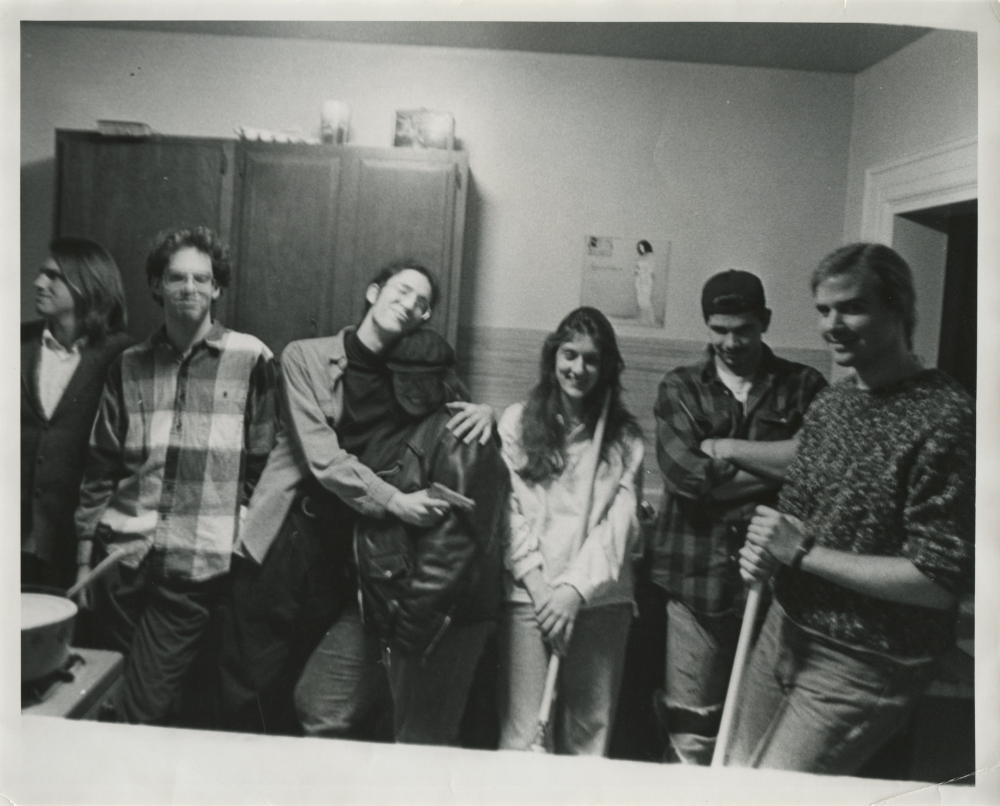 JJ, Chaz, Chad, Rebecca, Chrys, Ian, and TrentFor whatever reason the game really gelled, and took on a life of its own. I think part of it was that I used a version of a set of streamlined rules vaguely based on GURPs, that Silver Gordon and I had worked out. (the entire rule set fit on a single sheet or paper.) So the rules were very minimalist, which kept the game moving along at a good clip. The other element was that many of the people who joined the game later had not played RPGs before, and so they would being a different kind of thinking to the table. And also, any player who joined the game after the initial session, had a secret agenda that was tied back to one of the powers, whether they knew it or not. It took a surprising amount of time for the Player to realize that EVERYONE was a double agent. JJ Haws' character Charley Holl was an acute case of a character whose position as an unwilling double agent resulted in some classic moments in the game.
JJ, Chaz, Chad, Rebecca, Chrys, Ian, and TrentFor whatever reason the game really gelled, and took on a life of its own. I think part of it was that I used a version of a set of streamlined rules vaguely based on GURPs, that Silver Gordon and I had worked out. (the entire rule set fit on a single sheet or paper.) So the rules were very minimalist, which kept the game moving along at a good clip. The other element was that many of the people who joined the game later had not played RPGs before, and so they would being a different kind of thinking to the table. And also, any player who joined the game after the initial session, had a secret agenda that was tied back to one of the powers, whether they knew it or not. It took a surprising amount of time for the Player to realize that EVERYONE was a double agent. JJ Haws' character Charley Holl was an acute case of a character whose position as an unwilling double agent resulted in some classic moments in the game.
Character death was pretty frequent, and I think Chad's character Hopper was the only one to make it all the way through the campaign in one piece.
The game generally varied between 4 and 10 players, and went on for about 2 and half years, happening almost every Thursday night. I rarely knew what was going to happen in a particular game session, other then having an idea in my head about what the powers knew and were in the process of doing and a few news story printouts. In my mind, I was playing the as much as any of the players- it was just that my character was 'the world'. I had a huge amount of fun, simply trying to keep track of the multitude of parallel threads going on in the game. In most sessions, I would spend over half the game time in separate break-away discussions with different groups players, and they worked out their plans without being sure who in the group they could trust.
In the end, with graduation looming, I decided to end the game in a big finish, rather then let it die off like most other games. So I ran a pretty epic final game session down at the Virtual Gallery that had me running from room to room GMing non-stop for 14 hours.
A week or so afterwards I was riding back from a concert (or something) in Louisville, and JJ was having me explain the hows and whys of what had been happening to the game. So I was explaining who was working for who, why the Vatican was trying to kill the time-travelers, the secret behind the Tijuana shellacked frog, how the psychic storm in china was started by Rosenthal in the Swiss Evian bottling plant- all of it. And after listening to this for a while, Mike Hager turned around from the front seat and declared that that was the "biggest wad of Role-playing shit" he had ever heard. I took it as the highest form of complement. :D
Anyway, I found some of the documents from the game, and am posting them here. I think JJ wrote the Intro pieces, as well as the prison escape piece. While I was running the game, I rarely had time to actually document what was happening. I will post more when I dig them out of storage.
- Hopper's Intro
- Hopper's Character Sheet
- Hopper's Demands
- Charlie Holl's inial repoirt to the Annulate
- Charlie Holl's report on meeting the Renegades
- A transcript of Agent Lane and Insurance Man's escape from Prison
- Data request for Mandrake The future predicting super-computer
- Some random notes
- Epilog In 1997, I was looking into running an online version of the game with the old players, and typed up some notes on what had happened in the game world in the years after the finale.
